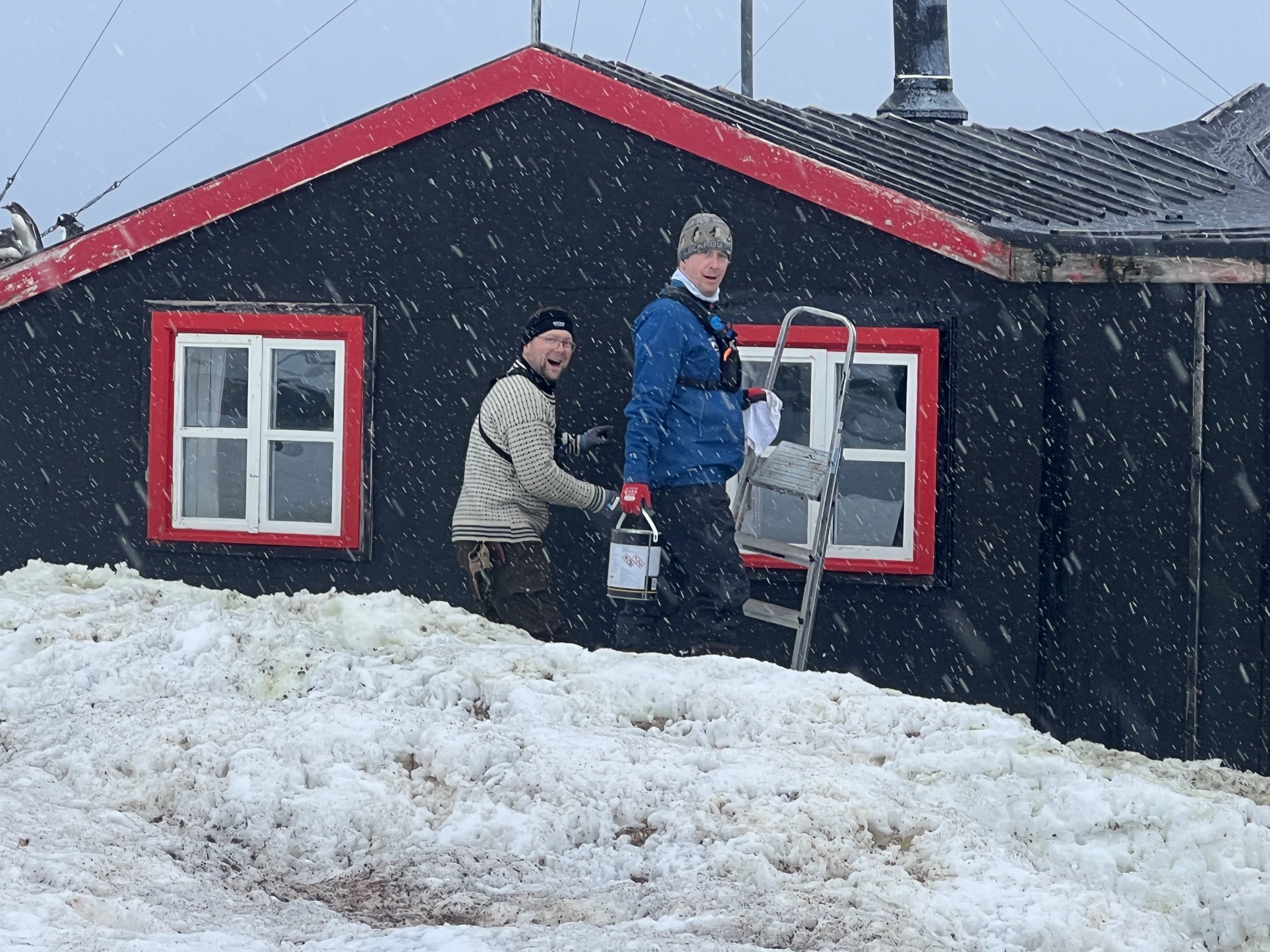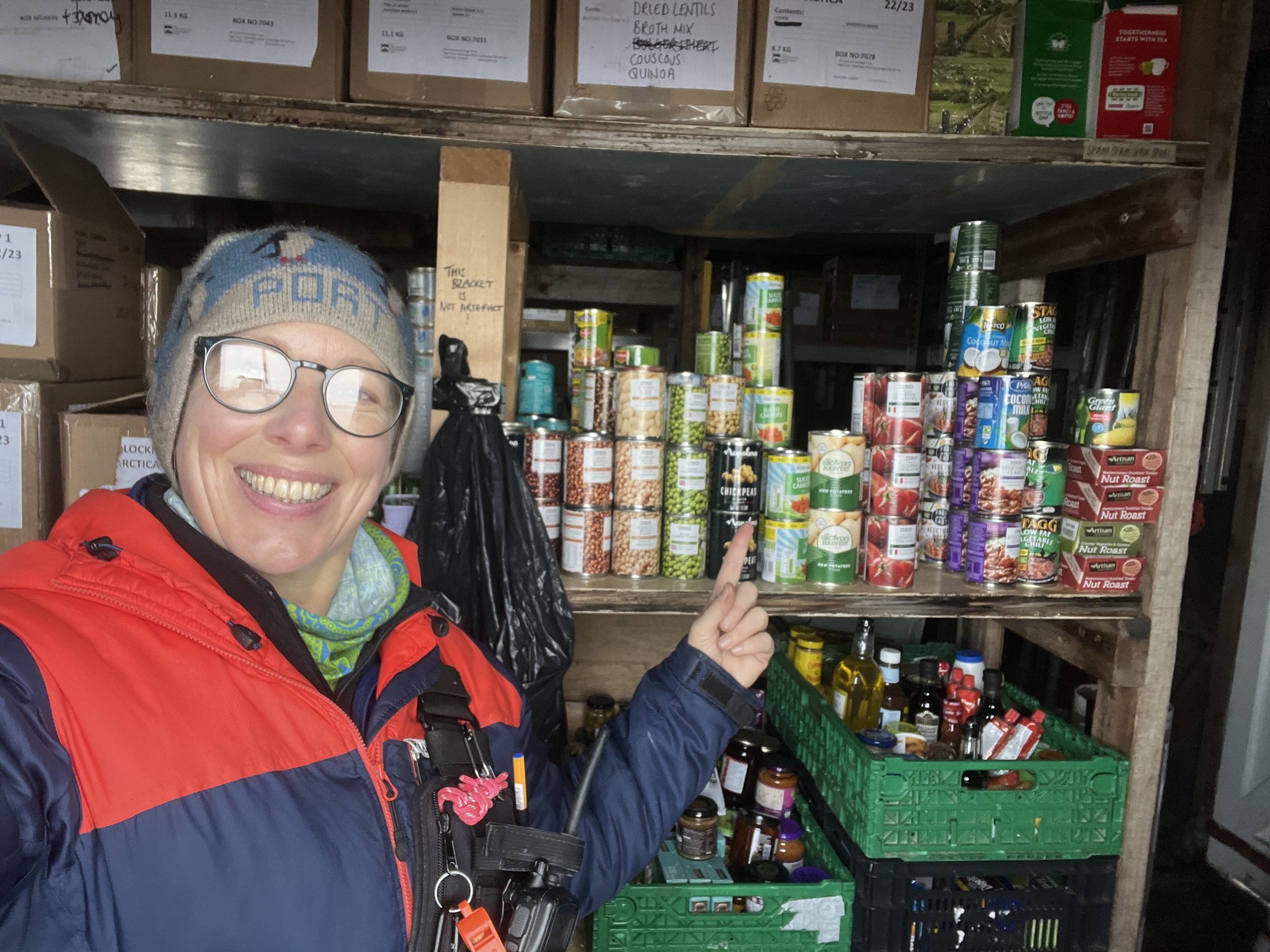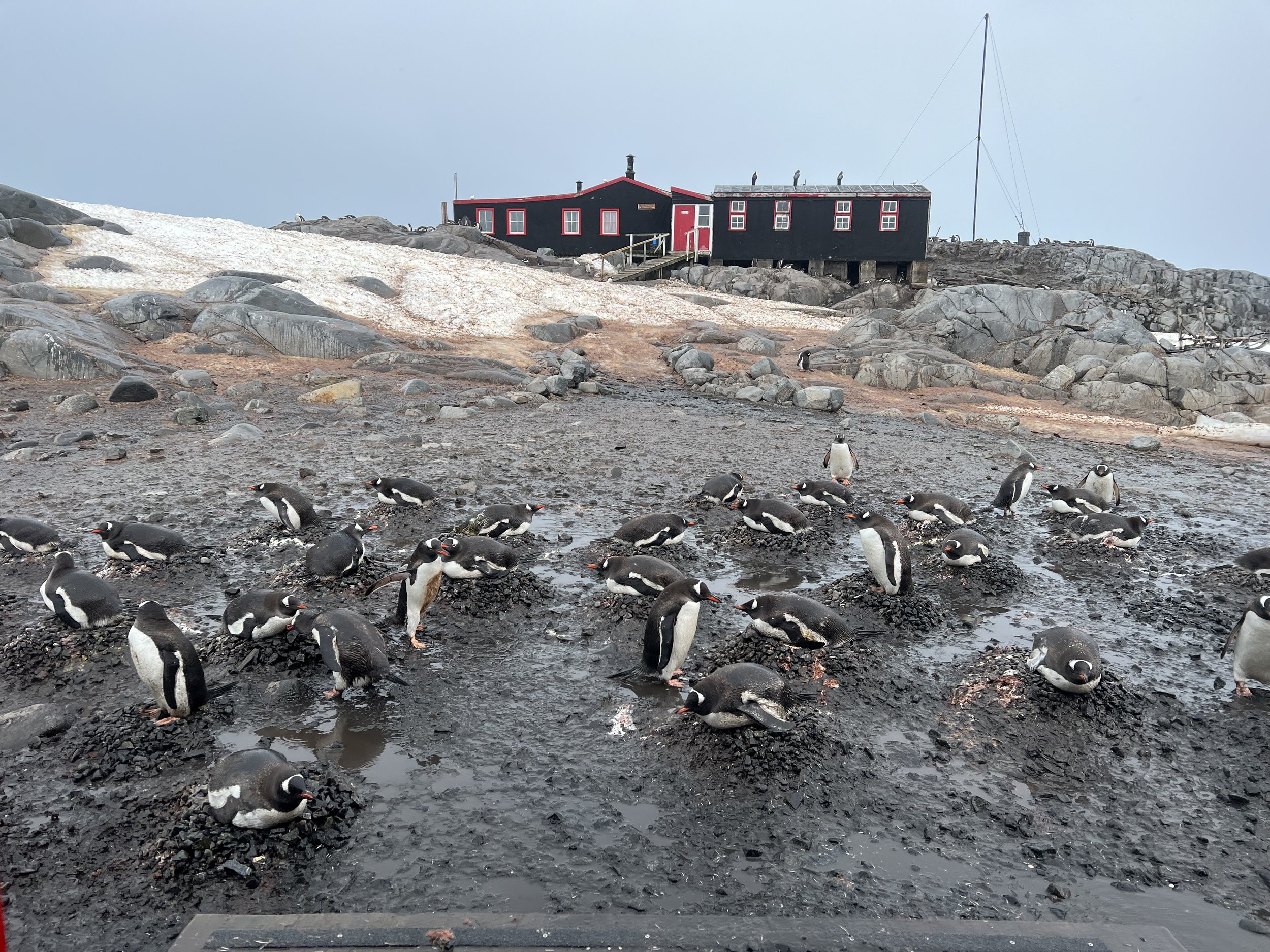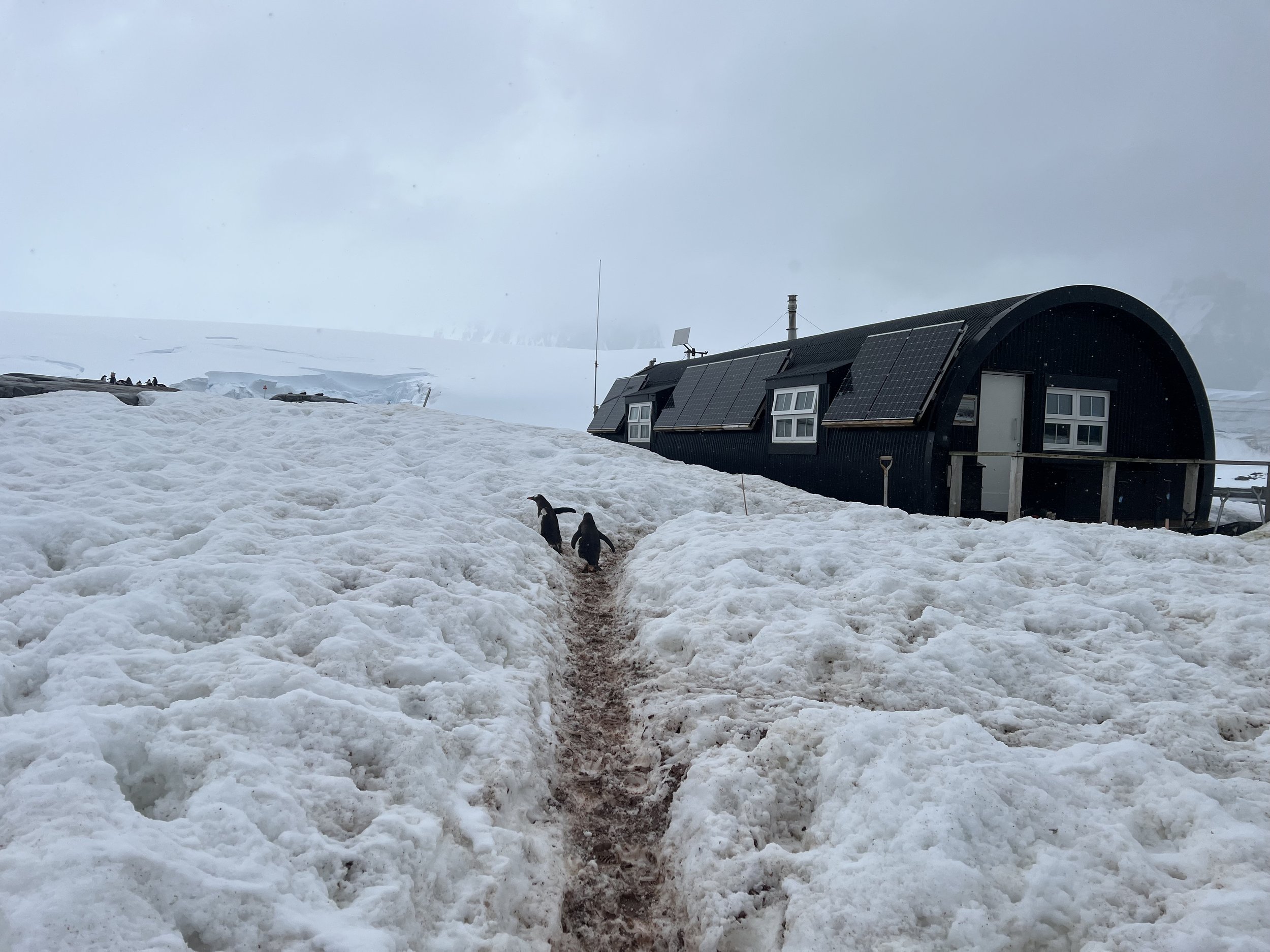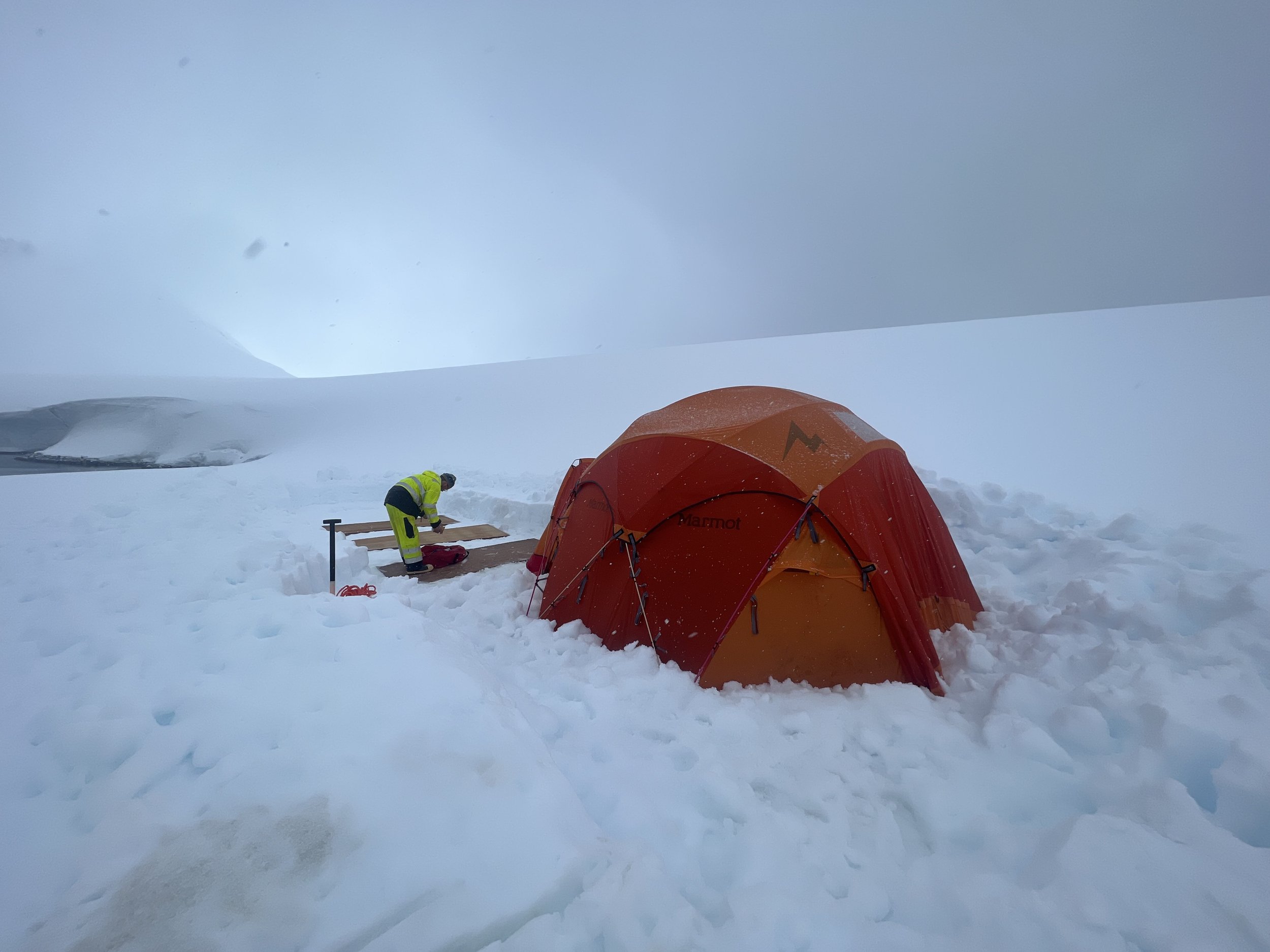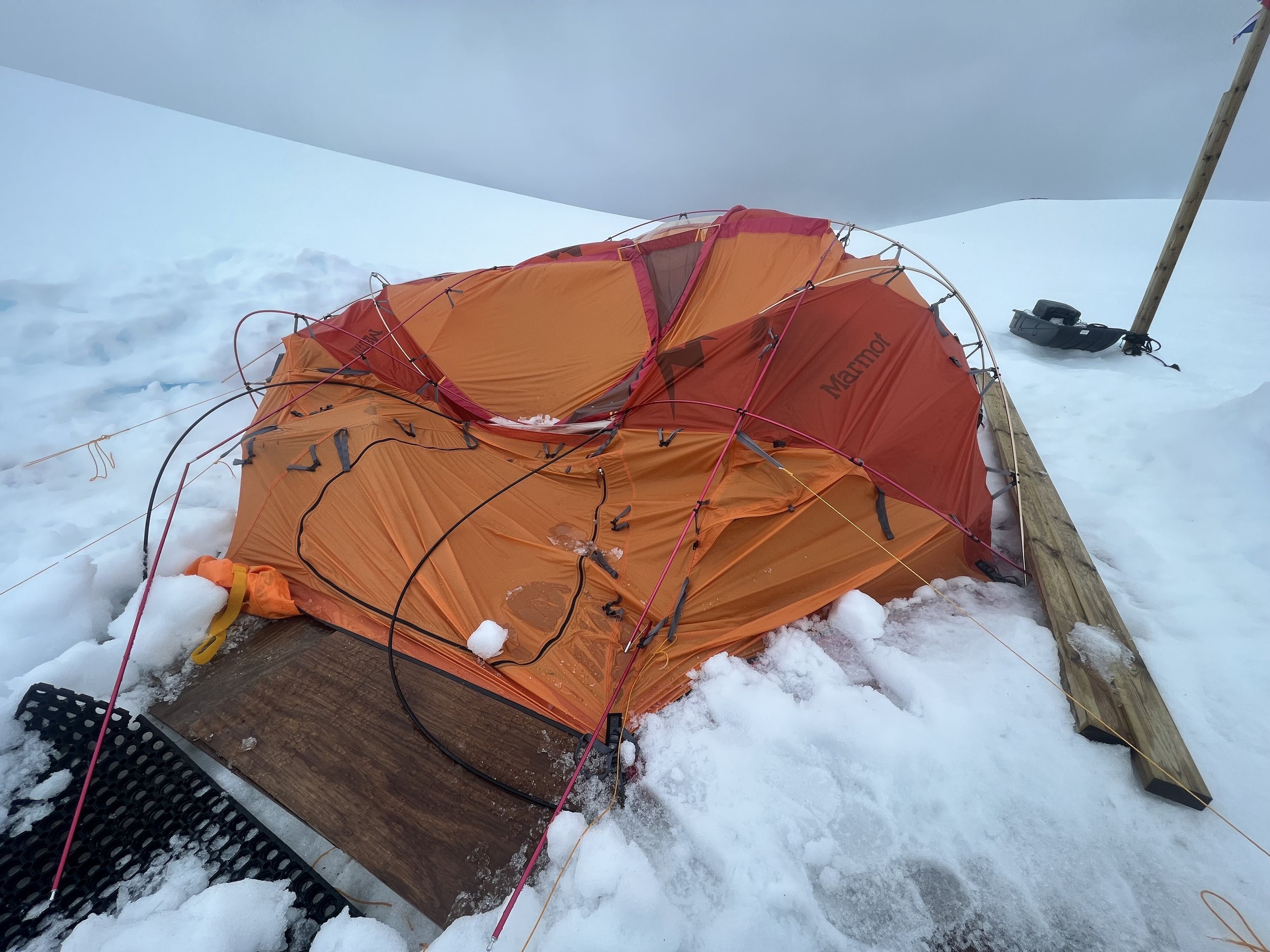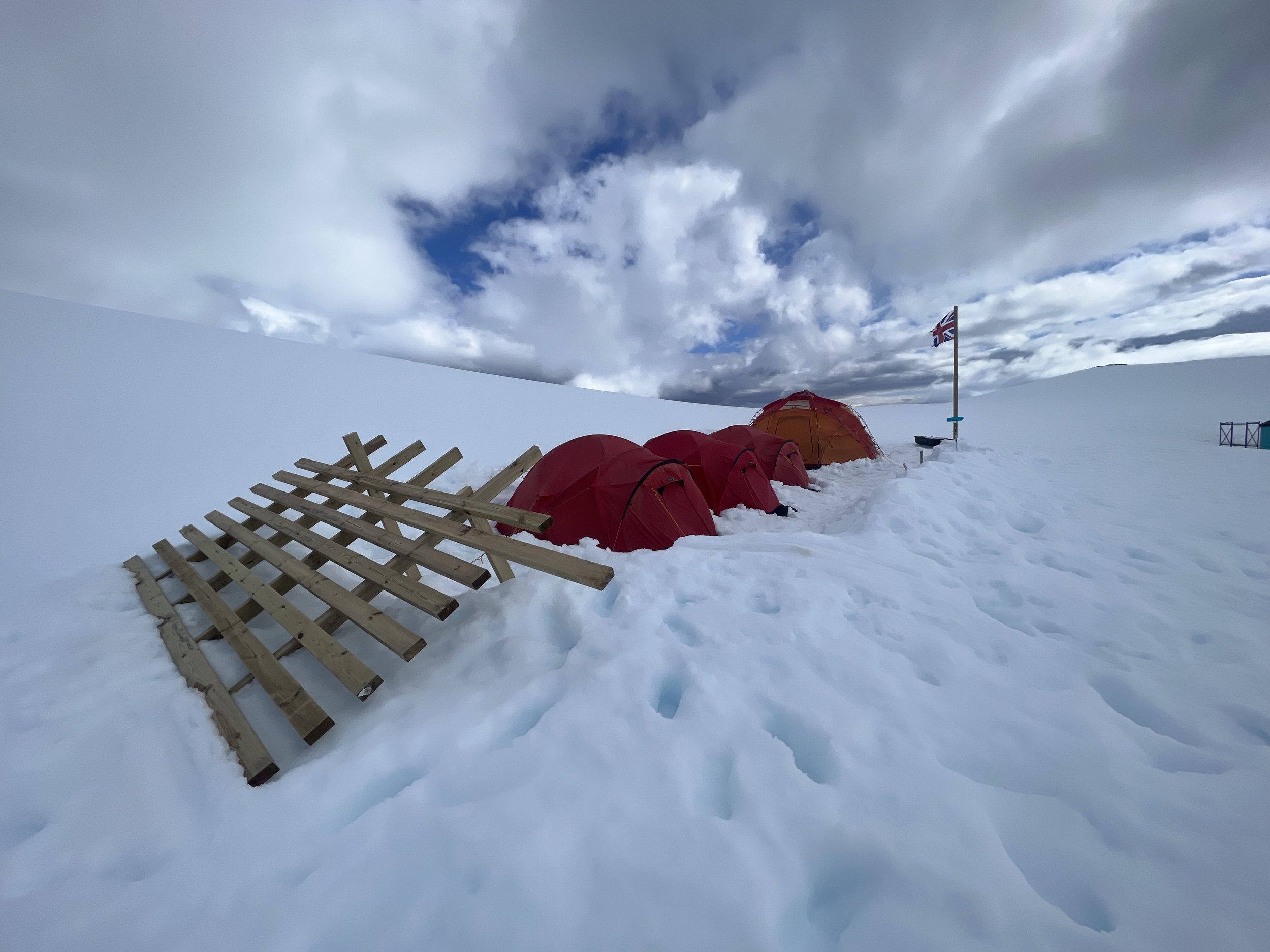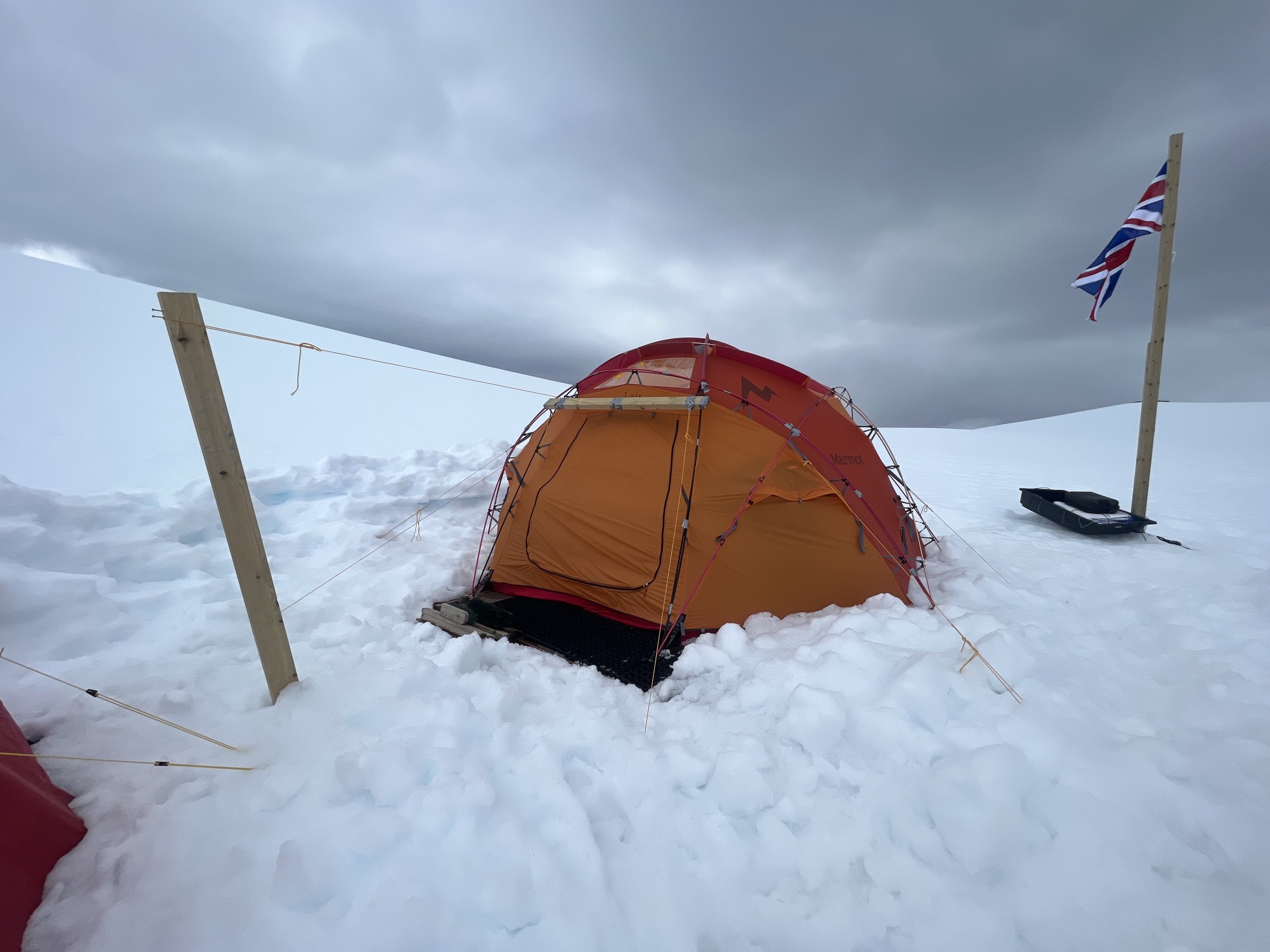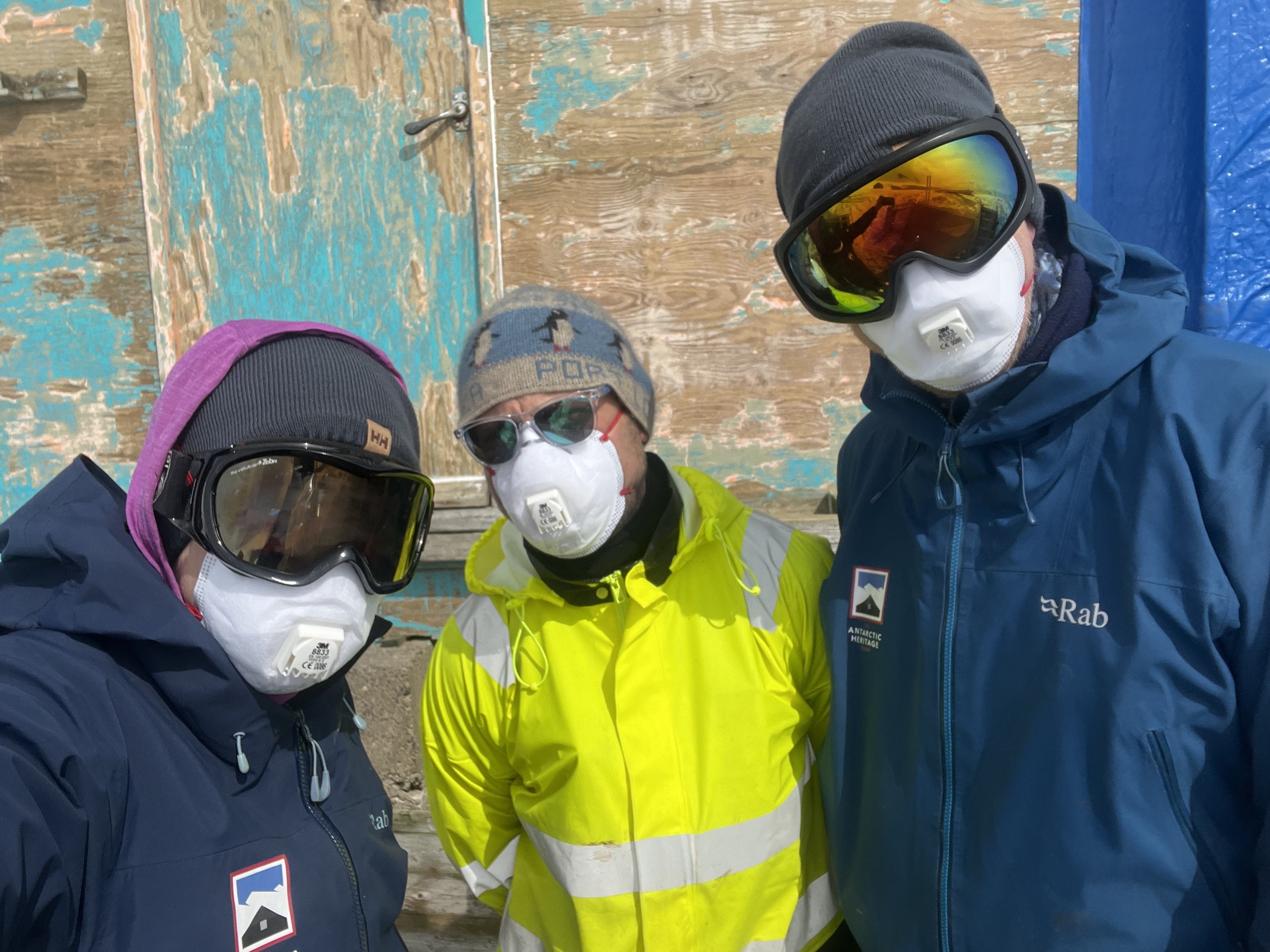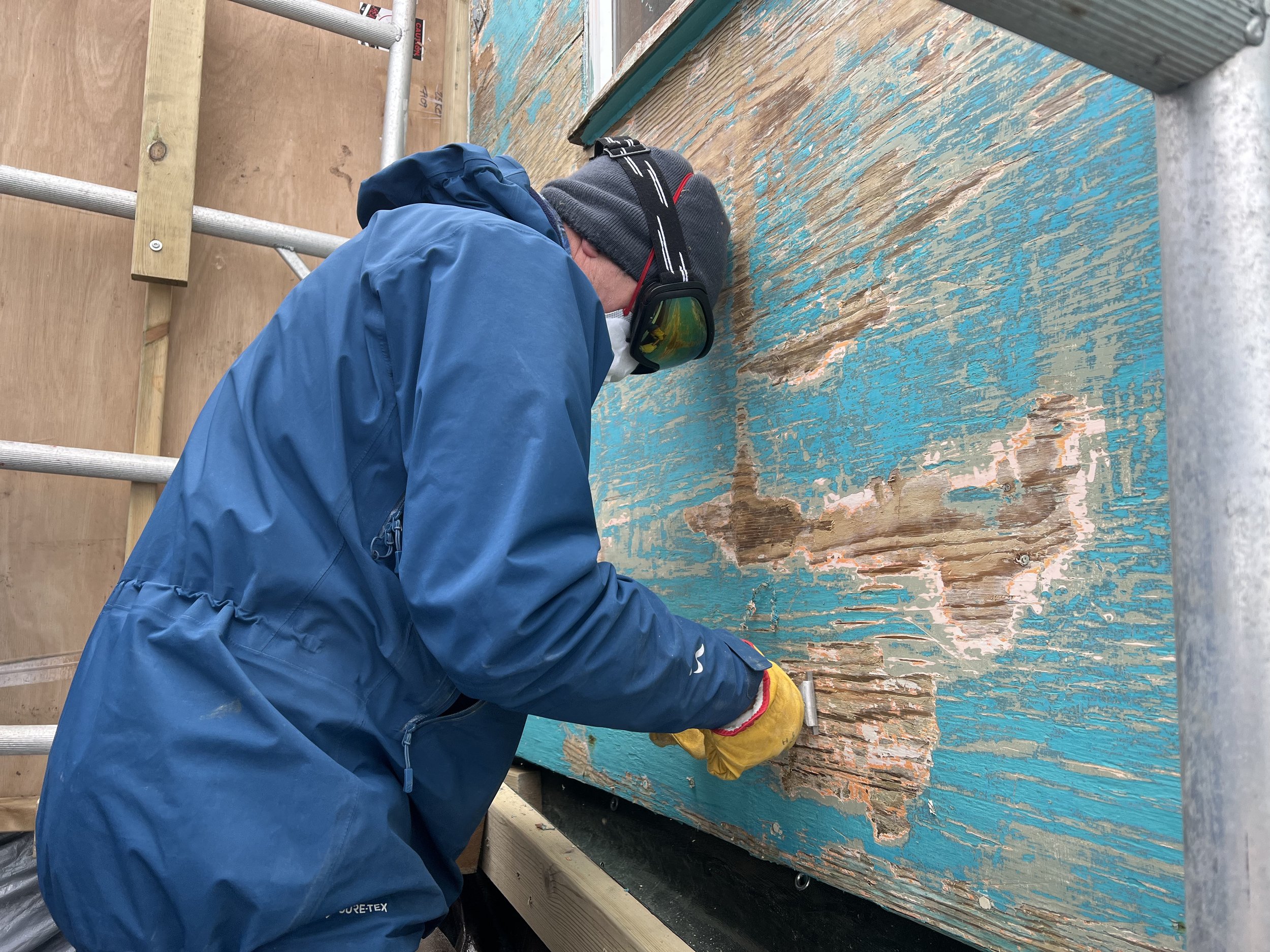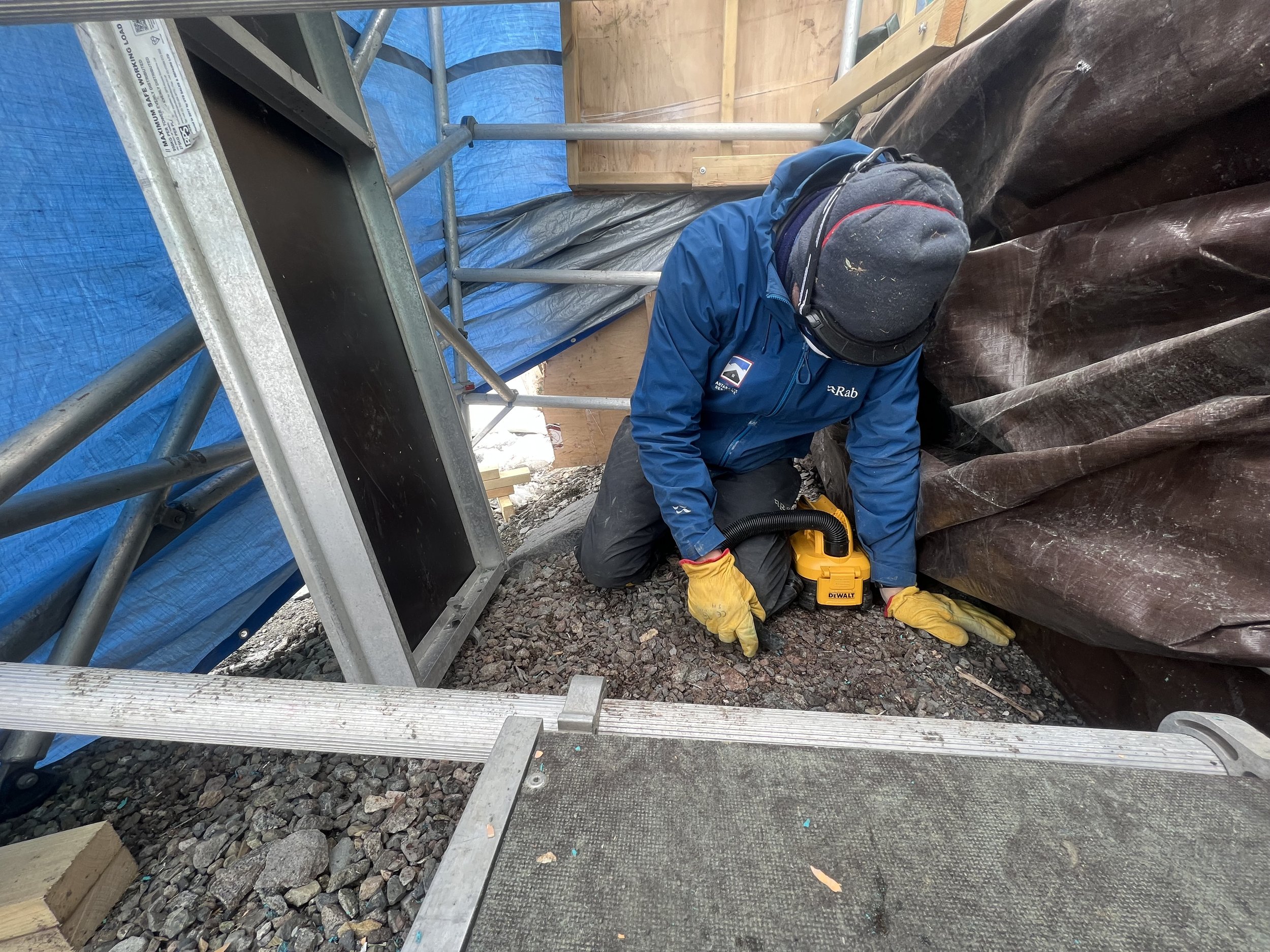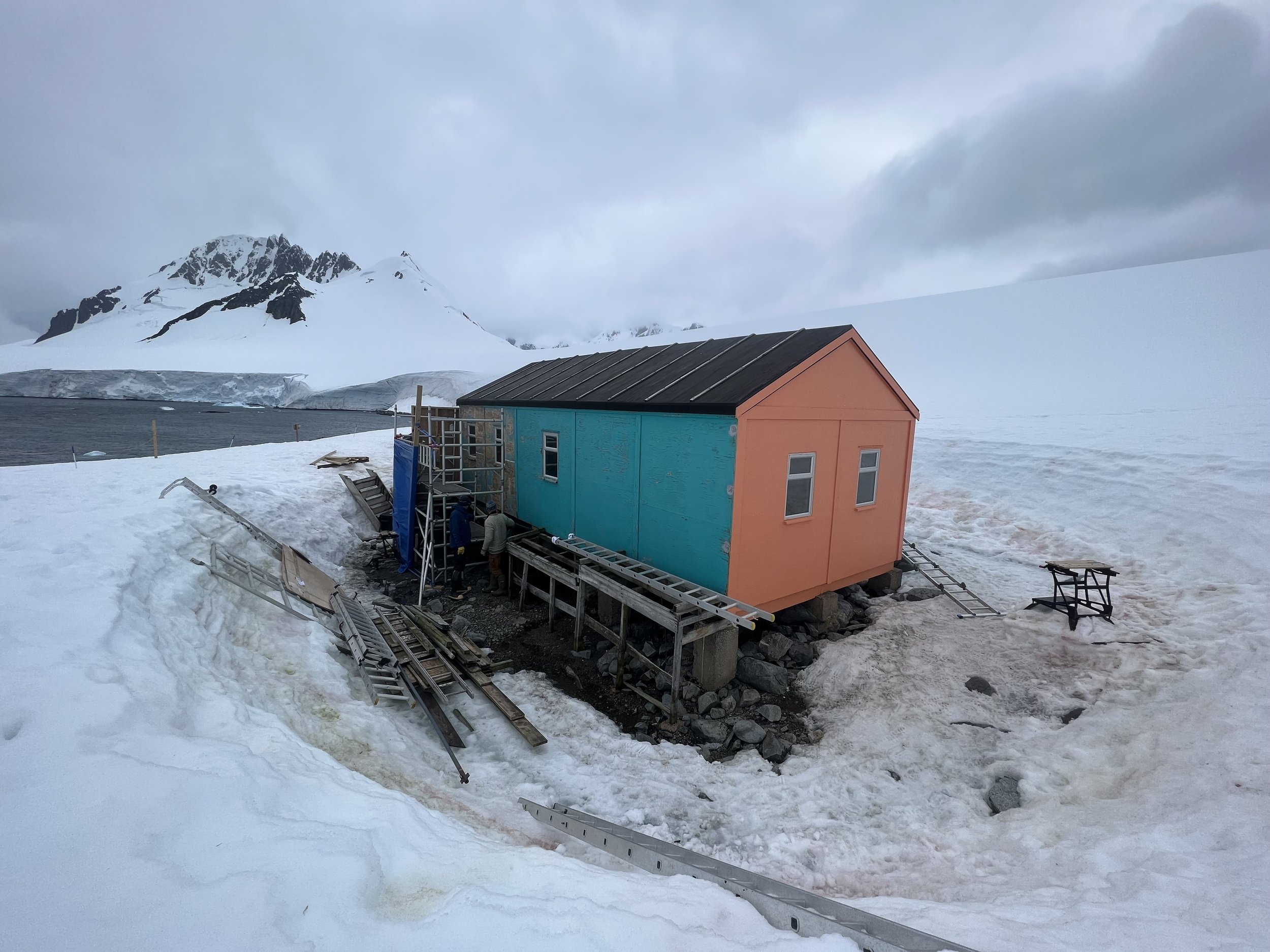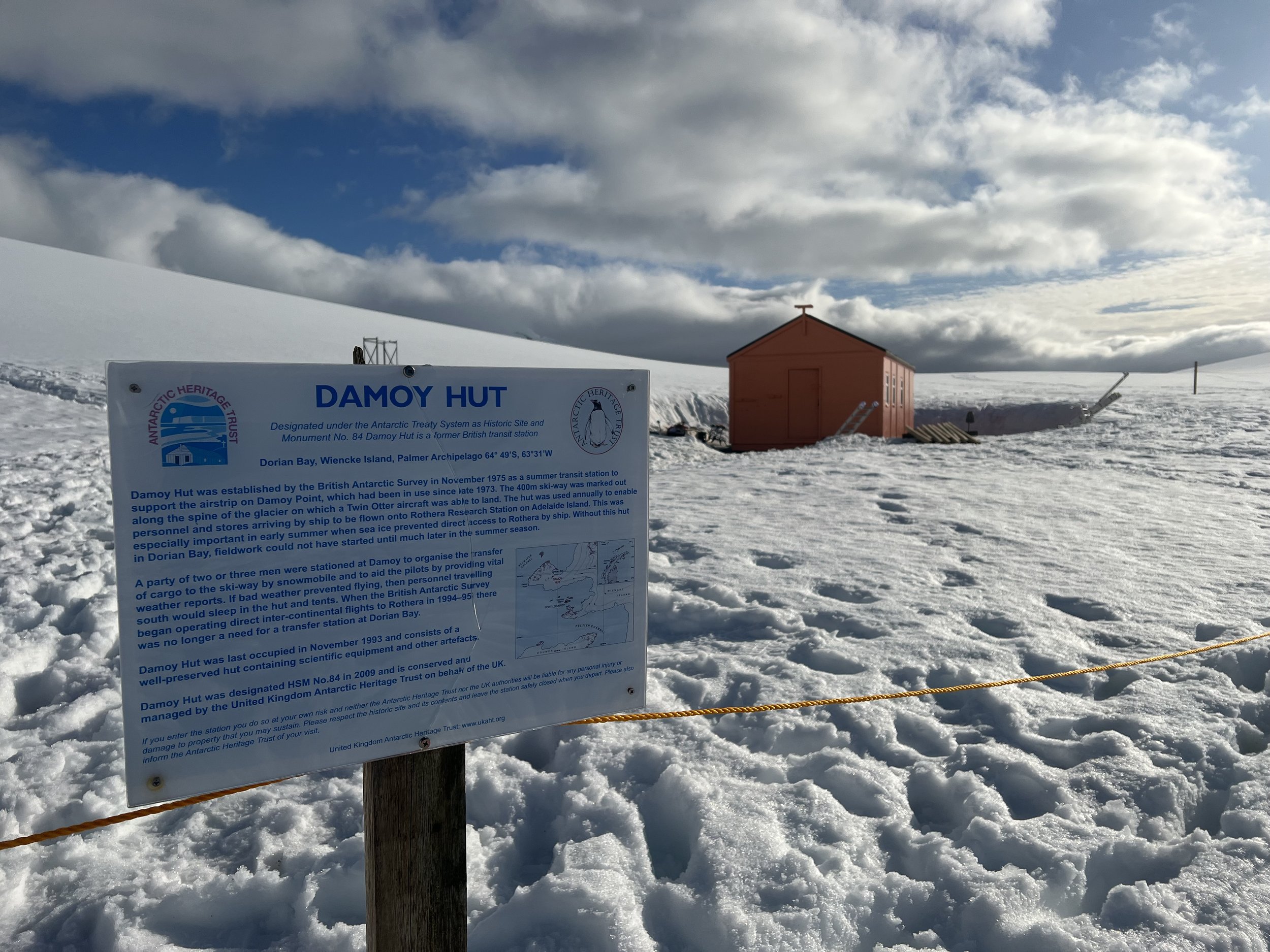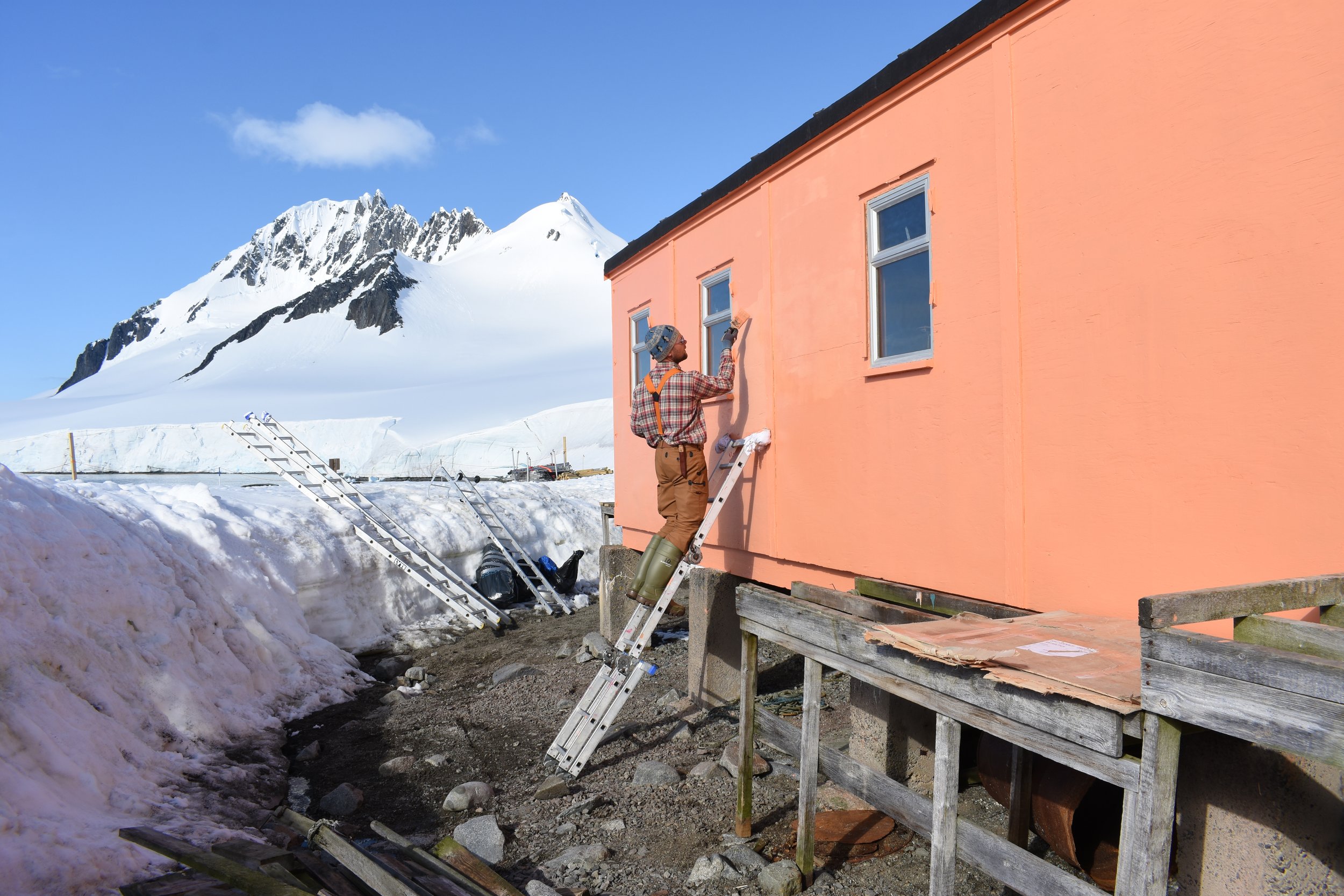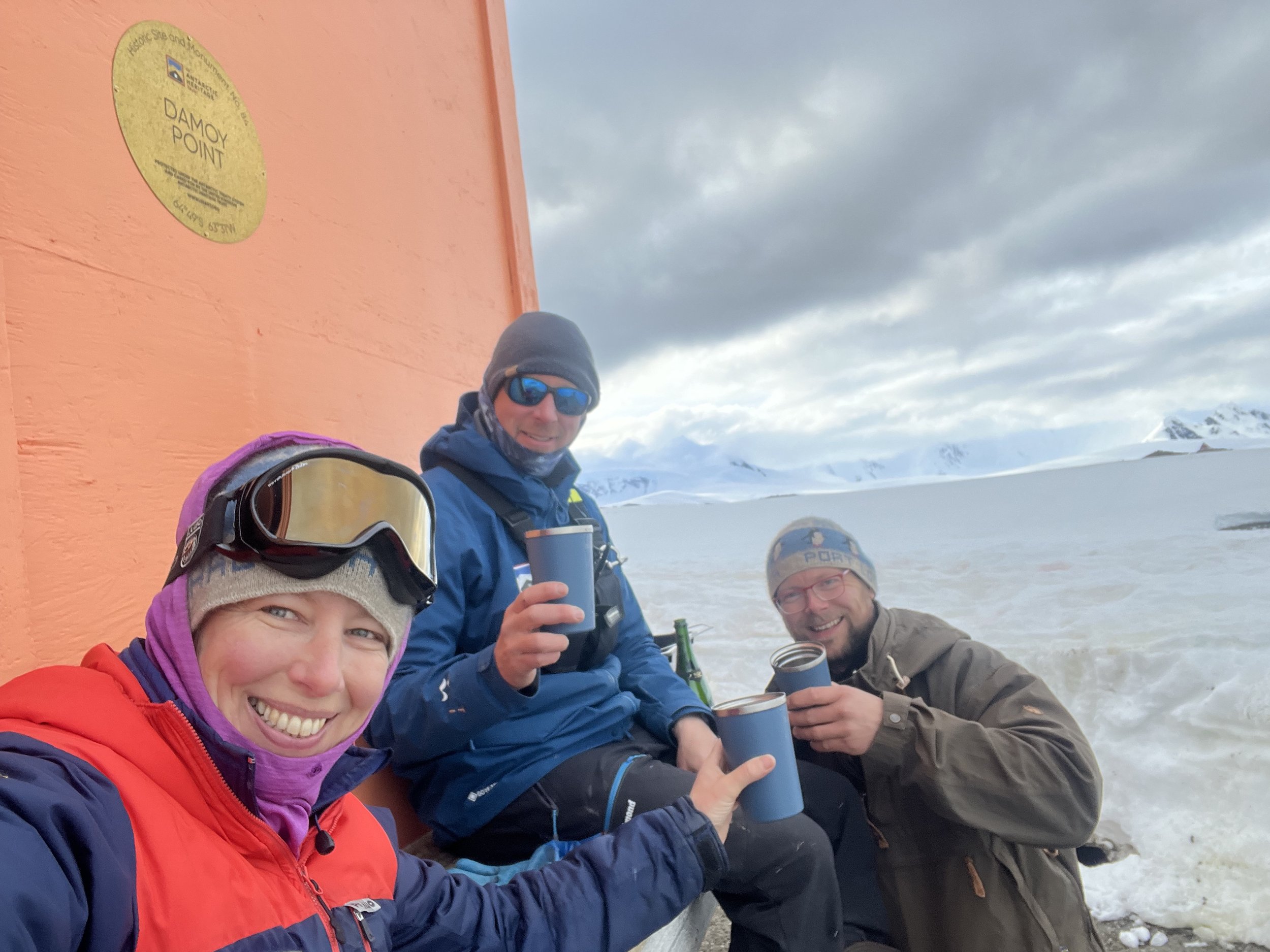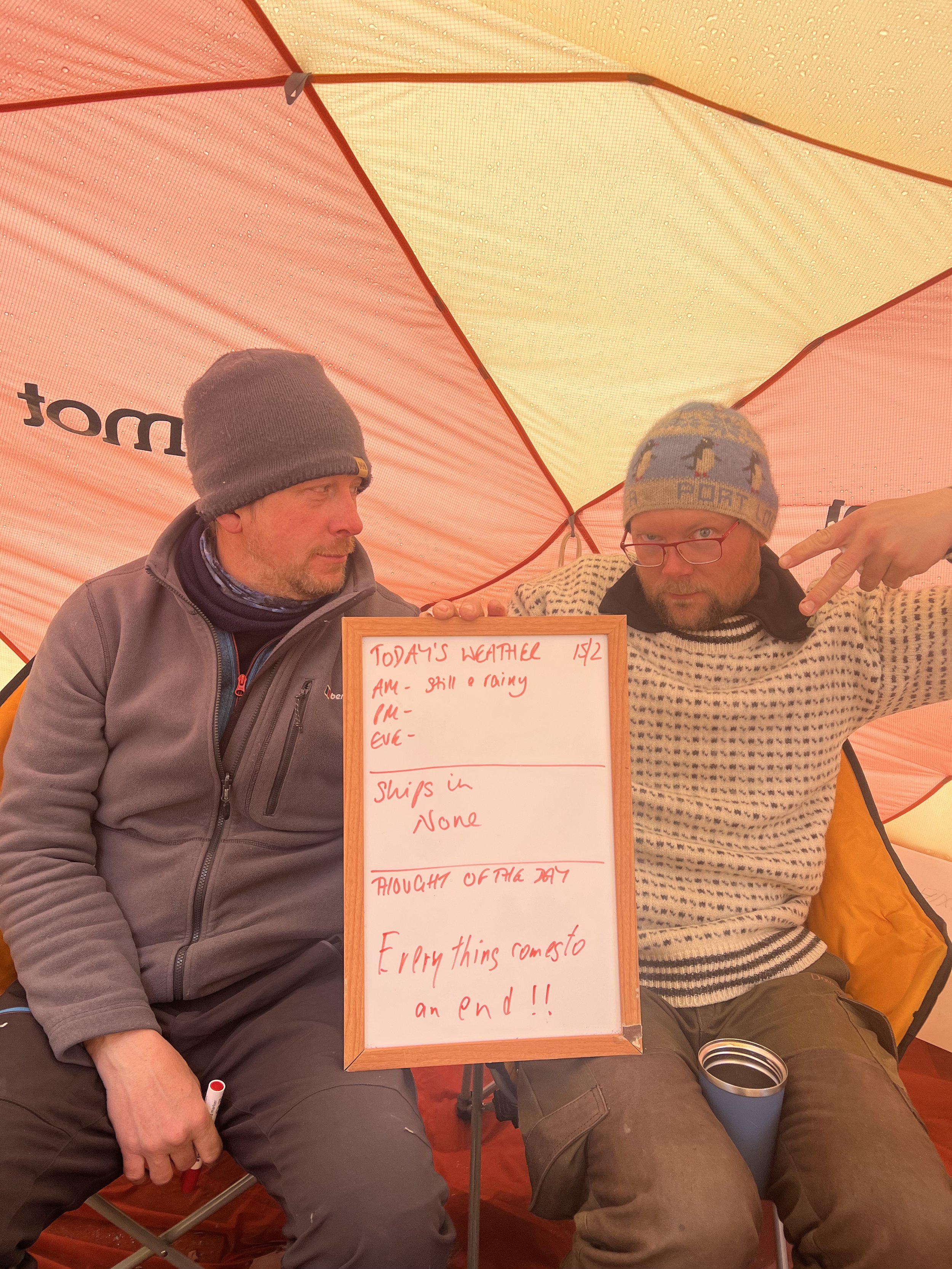Necessity is the Mother of all invention - 26 days of ‘summer’ at Damoy Hut
Orange is the new blue - myself, Sven and Martin after 26 days at Damoy
I was dropped off at my next job by a cruise ship on the Antarctic peninsula in early January, supposedly the Antarctic summer, and it’s snowing and freezing cold. Antarctica has its own ideas about the word ‘summer’ which we were soon to discover.
My Damoy co-pilots, Sven and Martin, and I were based at Port Lockroy for 10 days before HMS Protector was due to pick us up and move us and our stores around to Damoy, less than a mile in distance and around a 10-minute Zodiac ride away. We had a great deal of work to do before the move to our project site and as Port Lockroy is a protected heritage site and home of over 1000 Gentoo penguins, we quite rightly had a fair number of restrictions to deal with too from working in and around a protected monument to our snails pace walking around the wonderful penguins and the enormous amount of stinky poo they produce!
The history of Port Lockroy, also known as Base A and home to Bransfield House where the shop, Post Office and museum are located, as well as the Boat Shed and the Nissen Hut can be found here as it would take a whole blog to describe its history and current life on this tiny island so I will concentrate on what the 3 of us were up to in order for us to be ready for the off.
Whilst Sven and Martin cracked on with various conservation tasks on the island as well as pulling together the last of our equipment which was stored in the Boat Shed, I continued to get my head around the variety of operations manuals, sorting and logging our extensive first aid kit, getting to grips with the large variety of spread sheets which I would need to fill in from satellite phone logs to waste management and ship schedules. I also spent a couple of rather chilly days in the Boat Shed filling crates of dried and tinned food for our stores at Damoy and wondering how extensive our menus were going to be with what I had packed.
Our 10 days at Port Lockroy with 22/23 season team of Lucy, Natalie, Mairi and Clare flew by and before we knew it we were greeting HMS Protector’s Zodiac and crew for our first run to the ship to sort out the conservation equipment which they had brought down from the Falkland Islands. Our pick up and drop off was due to take place over 2 days however when the weather took a turn for the worse during the morning of day 2 whilst we had only completed 2 Zodiac journeys of our kit, the plug was pulled for safety reasons and the 3 of us were brought on board for our one and only night on a Navy ship.
Moving to Damoy
Bright and early on Sunday 22nd January we started our final commute to our home for the next 3 1/2 weeks and at 11.30am we waved goodbye to the Royal Navy and Marines who had helped to bring our stores and equipment ashore. That was that, we were on our own for the first time in nearly 2 weeks and it felt so good. Just us, Damoy Hut, the Argentine Refuge and a lot of Gentoo penguins. With our sleeping tents and mess tent up and safely secured, there wasn’t a breath of wind and all we could hear was the call of the Gentoos in the distance. That evening I went down to the hut to close it down for the night after dinner and as I came out through the front door I was greeted by Pepe, a very bold Gentoo who had wandered up to the hut to see what was going on. I think we were both a bit surprised to see each other but it didn’t phase him as he waddled down the snow slope to the bottom of the hut stairs, had a sniff around, called out to his mates as if to say ‘yup, this lot are ok guys’, waddled back up the slope and then headed back to his colony down by the beach. What a first night!
Our first night at Damoy
‘Work’ and ‘home’
As alluded to in my first blog ‘A long commute to work’ my job title was that of Field Guide however when we were settled in I took on the role of Field Camp Manager, making sure that everything worked smoothly at our site so that Sven and Martin were able to concentrate on their jobs. During our first full day on site, whilst Sven and Martin were sorting out their equipment and starting to strip the south gable end wall, I busied myself with sorting out our mess tent, to be known as ‘home’ as well as chatting to passengers from the 2 Hurtigruten ships who were making landings during the morning and afternoon. I had set up a rope cordon the night before to discourage anyone from coming into our work area but realised very quickly that it was too close to the hut as we were being sucked into conversations with very interested guests too often. As lovely as it was to chat to the passengers and expedition team time was tight for our project and there was no Plan B so every minute counted and that night I was busy with some 2x4, a saw and some longer lengths of rope to extend our quiet zone.
Our first day had been a busy and a windy one. Loads to get sorted, working out what worked well and what didn’t however we were in for a big welcome to Antarctica that evening. We had been given a forecast by the ships in that day that wind gusts of 30 knots were due that night. With a fairly gusty night ahead we battened down the hatches at both home and work. It was due to hit around midnight and as we sat having our dinner, the porch on our mess tent started to buckle. I went outside and hung onto it for dear life, calling out Sven and Martin to help me take the poles out and tie it all down. We were testing out this mess tent and we were about to find out what it was made of.
Necessity is the Mother of all invention
We hunkered down in our own tents and spent a sleepless night being battered by the much stronger winds than forecast. As I lay against the side of my tent, trying to help it stay upright, all I could hear was the roar of the wind which sounded like a constant freight train thundering over Jabet Peak to our north east. I kept sticking my head out of my tent during the night to make sure the mess tent was still with us and as battered and flattened as it looked, it was still with us. At 7am I radioed the guys to see how they were doing. Martin’s tent, at the far end of our line, was taking the brunt of the wind and snow so I made the call to abandon our tents and head to the hut. We had been in the best place until then as our weight held down our tents but with the wind was still strengthening and Martin’s tent starting to be buried, enough was enough.
From then on until midday we sat in Damoy Hut, keeping an eye out of the window to see if our tents were surviving. Come midday as the wind suddenly dropped we walked back up to ‘home’ to assess the damage. It didn’t look good. The mess tent had collapsed, the poles were bent beyond what was normally their breaking point, our sleeping tents were at a variety of wonky angles and it was all a bit of a mess. The 3 of us stood there and thought that our season was over already as without a mess tent we had no ability to cook and our season would be in jeopardy.
‘David Willis asked - Curious to know why you were not sleeping and living in the Damoy hut’ which is a question I had quite often. Damoy Hut is a historical monument and site so living in the building was a no-go from the start. We were also not allowed to cook inside the hut as it would not have been good if we had burnt down the hut with our cooking flames. We also had a great deal of kit which took up the floor space of the bunk room, the bunks were laid out with historical items from original sleeping bags and matts to snowshoes and woolly jumpers so there was no room for us. Our tents were our little havens and we were quite happy to shut the door on work at the end of a long day and head home.
As we removed the water which was holding down the mess tent, incredibly the poles sprang back and the dome popped itself up. Necessity is the Mother of all inventions and whilst Sven and Martin got to work strengthening the mess tent, adding bracing bars, extra poles and extra rope I bailed out the inside and put everything back where it was meant to be. Martin then constructed a wind and snow break next to his tent for some shelter, we dug in our tents again, sorted out any mess down at the hut then all crashed out. It had been quite a 24 hours. Welcome indeed to Antarctica.
Finding our rhythm
That storm, with recorded maximum wind gusts of 70 knots, was a big learning experience for us as a team and it bonded us well. Over the next few days we began to get into the rhythm of life on an Antarctic island where the weather forecast invariably erred on the light side so we were constantly prepared for harsher weather, and a good routine for home and work.
Our daily routine, asked by David Merrington, was a very simple one. We would wake up around 6.30am, probably having been awake for a while listening to the Gentoo penguins and I would open up the mess tent and put the kettle on. We came to the realisation within the first couple of days that in order for Sven and Martin to spend maximum time on the hut that I needed to be in charge of cooking lunch and dinner plus sorting 11ses and mid afternoon tea. Sven and Martin would take it in turns to cook breakfast and whoever wasn’t cooking would do the washing up. When the guys went off to work, I would clean up home, send out a daily proof of life email to the office via our BGAN satellite system, welcome any ships who were landing their passengers at our site or go on board and do a talk about our project.
Elevenses would come soon enough then I would prep lunch which was usually soup, cheese and crackers or some sort of couscous dish. After a few more hours work, the kettle would be on again for our afternoon cuppa and biscuits and I would start dinner usually to be served between 7.30pm and 8pm when the guys would finish up. They were long days but we knew we were chasing time and also had to work around the weather.
Whilst I was doing my variety of mess tent jobs, I was also filling in various spread sheets, sending off reports, trying to sort our emails which we could send but not receive for the first week on site, dig out the tents if it was snowing heavily, dig in the tents if it was raining or sunny, ensuring that they were secure. When a rip appeared in the top of Martin’s tent, I Superglued a patch in place as my first attempt with Duck tape did not work due of the damp and cold conditions. If something didn’t work the first time, which was quite often, we tried a different way and carried on until our problem was solved. The creative side of our brains were certainly being put to good use.
Sven and Martin also had a work rhythm of their own. The south gable end wall was stripped of the old paint within the first few days and with the primer on and dry, it was time for the first coat of paint to go on. We were 100% at the mercy of the weather. Too wet and we couldn’t paint, too windy and we couldn’t strip the hut or paint, snow was ok for stripping old paint but not for new coats, too much sun and the paint dried too quickly, too cold and it didn’t dry quickly enough. We were working in tough conditions and did worry that we wouldn’t get all 4 coats onto the hut by the time we were due to be picked up mid-February.
Another role of mine was to sort the various medical kits to ensure that we had cover wherever we were. The likelihood of an accident was low however the consequences were very high so we needed to be prepared not only with our various kits, but also what we would do if one of us did have an accident. We were fortunate to have ships in the area fairly often and all ships bar the smaller yachts have Doctors on board so we had potential help and evacuation nearby plus medical assistance on the end of our satellite phone but as we all know, the best med kit is an unused one.
I was also happy to muck in and once I had completed my base set up jobs I picked up one of the scrapers and became a third conservator which I continued to do in between my other jobs until we had stripped the entire hut. It was hard work and the ease at which the paint came off was very weather dependant. Too cold and it was like concrete, very wet or warm and it would peel off nicely. Each side of the hut was different as it was battered by different strengths of wind and was either more sheltered from moisture or had the full force of snow and rain.
We loved being at the hut and the life we were carving out during this unique project. On a rare day of good weather we would go for a walk up to the top of Tombstone Hill and spend a little time taking it all in. What a special place to be.
Cracking on
Time cracked on at the hut as did our project. The final paint stripping was quite a moment in time and we were very pleased to have finished that part of the project. Antarctica is supremely protected and it was important for us to collect as many of the paint flakes as possible. When the guys set up the scaffolding they also set up a tarpaulin bib for the paint flakes to drop in to. Once we had finished a panel we would then go around with the hand held vacuum cleaner and would literally hoover up the rest and then go around picking up any rogues pieces to ensure nearly 100% of flakes were taken away.
Fur seals and Pepe the Penguin, life with the wildlife
The wildlife around us was incredible and we were very aware that we were living on their island and in their territory. We regularly had visits from a penguin or two, had a few resident Skua pairs and youngsters who became very used to our comings and goings, watched Weddel seals sleep on the snow spit across from the hut and marvelled as a Fur seal bounced its way up towards the hut, had a mooch about then hot flippered its way back to the bay. I really miss the sound of the penguins, it was a constant of our time in Antarctica. Penguins smell is quite something, acrid and strong which burns the hairs in your nostrils and we were fortunate to only smell them when a north wind blew as their colonies were to the north of our hut. Very lucky for our noses!
Some would expect life down there to be mundane as we were very much into a routine however every day was very different. We were 100% focussed on getting the job done as once our time was up that was it, no chance to return and finish the job.
Job done
As hard as we worked and although not much down time was had, we did have a great time. I am really interested in people and getting to know Sven and Martin, what their back stories are, what makes them tick, learning new skills from them as well as learning what makes them grumpy (we are all human!) was fascinating. They also found out what makes me grump (I am human too!). I don’t think I have laughed so much on any expedition in the past and it was a joy being in their company.
Before we knew it the last coat of paint went onto the hut, the jobs were completed and our time at Damoy, this very special place, was over. We had endured a few more huge storms and marvelled at our first sunset as the nights drew in and 24 hours of daylight departed and I am glad to report that with a lot more TLC, screws and wood, our mess tent survived. We became experts at wind speeds in meters per second, became part of a whole new industry, met some wonderful people, made new friends and contacts and drank some amazing Malbec. 26 days is the longest I have spent in any one location, barring Covid, since 2010 and as much as my legs wanted to go and do some walking, I loved being part of the next piece of Damoy history in this truly extreme environment.
I could have written twice as much about our 26 days on project however will be getting into the nitty gritty of our time at Damoy in my next blog. I’ll be taking you through our food and other daily routines, what I wore and what I wished I had taken with me before my final blog telling adventure tales about the wonderful people we met, but before I go, did I tell you about the wind?!


